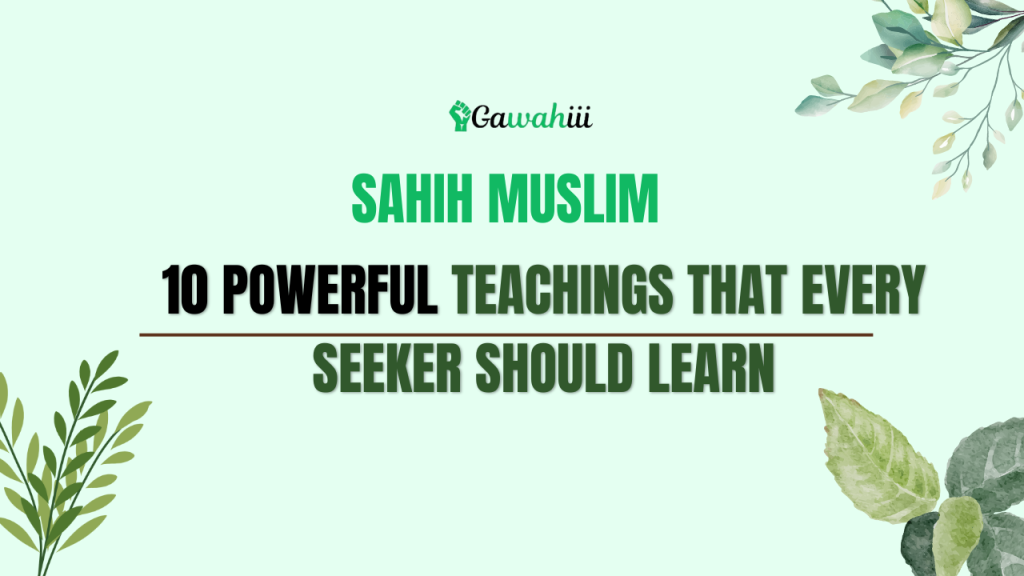Introduction
Out of all the writings from the Islamic tradition, only a few equal the significance of Sahih Muslim. Besides Sahih al-Bukhari, the Sunni Muslim community has relied on this compilation of hadith to direct Islamic studies, law, and daily life for many years. Since people are increasingly seeking true Islamic texts, Sahih Muslim gives clear, historical, and enlightening guidance.
Whether you wish to discover why Sahih Muslim is important as a college student, researcher, or average person, you can rely on this article. We will analyze the Four Sources and their important aspects to understand why they are significant and useful for modern Muslims.
What Is Sahih Muslim?
Sahih Muslim belongs to the six most important hadith books in Sunni Islam (Kutub al-Sittah). In the 9th century, Imam Muslim made this book, which is considered second only to Sahih al-Bukhari for its authenticity.
- The book was compiled by Imam Muslim (Muslim ibn al-Hajjaj al-Naysaburi).
- Period: 821 to 875 CE
- The collection is seen as the second most authentic in Sunni Islam.
- Volume 1 has approximately 7,500 hadith (when counted by repetition).
Imam Muslim used strict rules when assembling his collection. He only relied on genuine hadith (sahih) and strictly checked the reliability of people narrating them. Unlike most books, Sahih Muslim is well-organized and well-written, which helps students access it more easily.
Key Features:
- The books are arranged based on topic rather than the chain of transmission.
- Gives importance only to narrations supported by a stable and unbroken series of verifications
- Explains matters in detail and provides the appropriate context.
Biography of Imam Muslim
Understanding the scholar Imam Muslim helps us appreciate his work all the more.
- The person’s full name is Abul Husain Muslim ibn al-Hajjaj al-Naysaburi.
- He was born in 821 CE in Nishapur, Iran.
- Death: 875
Academic Background:
- Learned from Imam Bukhari and Ahmad ibn Hanbal, who were both highly respected scholars.
- Traveled around Iraq, Hijaz, and Egypt to gather hadith.
Legacy:
- He was noted for his careful approach to all matters and his truthful attitudes.
- The playwright received recognition from those living at the time as well as those who came after.
- Many Islamic universities and leading seminaries are still studying Imam’s work.
Key Traits:
- Methodical
- Detail-oriented
- Strong commitment to keeping things real.
Methodology Used in Sahih Muslim
Imam Muslim used a new approach in compiling hadith, which is still considered the main approach in the science of hadith.
Key Ways Methodology Is Used:
- Every narrator in the Isnaad was required to be honest and have a good memory.
- No space should remain in the chain of narrators.
- Examining the actual words in the hadith to arrive at conclusions
- No weak or fabricated Hadiths are allowed in Methodist texts.
Here is a side-by-side comparison of how the authors of Bukhari and Muslim wrote their books.Criteria
| Criteria | Sahih Bukhari | Sahih Muslim |
|---|---|---|
| Narrator Meeting Requirement | Yes | Not always required |
| Chain Strength | Stronger | Strong |
| Arrangement | By isnad and topic | By topic only |
| Commentary Included | Less | More contextual details |
Importance in Sunni Islam
Compared to other works, Sahih Muslim is given significance by being called the Sahihain in the Sunni tradition.
Why It Matters:
- Shapes and guides the practice of Islamic jurisprudence (Fiqh).
- It appears in sermons, decisions made by scholars, and textbooks.
- Contains information on what the Prophet Muhammad (PBUH) said, did, and accepted.
Common Uses:
- Guide for those who work in law and legal studies
- Inspiration and guidance for lay Muslims come from these schools.
- Journals and medical libraries you can use for Islamic studies
Examples of Topics Covered:
- Prayer rituals (Salah)
- Traveling for religious reasons
- Morals and ethics
- Contracts and legal deals
It is still important and relevant due to how deep it is, how authentic its message is, and because its universally applicable values are very realistic.
Structure and Organization
The way Sahih Muslim is organized makes it very clear and convenient to refer to or study.
Main Divisions:
- A total of 56 “kutub” texts exist.
- Options are bundled into groups by subject or core Christian belief (faith, purification, prayer, charity).
Organizational Highlights:
- Instead of repeating words too much, similar variations from context are put together.
- Features extra sentences by the compiler to make the words clearer
- Browse through the material effortlessly with the help of cross-referencing.
Example Topics by Book Number:
- Book 1: The Book of Faith (Kitab al-Iman)
- Book 5: The Book of Purification (Kitab al-Taharah)
- Book 9: The Book of Prayer (Kitab al-Salat)
Authenticity and Scholarly Consensus
- Since literature has clear categories, it meets the needs of scholars and casual readers.
- Solar systems are a scientific fact accepted by most scholars.
- All experts agree that Sahih Muslim plays a central role in the field of authentic hadiths.
Scholarly Views:
- Imam Nawawi compiled an extensive discussion of the text to show it is reliable.
- Ibn Hajar mentioned it frequently when mentioning Sahih Bukhari.
- Modern Scholars: Keep up its reputation within the field of Islamic studies.
Reasons for High Authenticity:
- Strict checks to ensure security
- Proper passage of goods
- No presence of poorly developed narrators
Comparison with Other Collections:
- Has less material than Musnad Ahmad.
- Abu Dawood Shaddan contains more themes than Sunan Abu Dawood.
This agreement among researchers guarantees that Sahih Muslim is a mainstay in Islamic education.
Modern Relevance of Sahih Muslim
Sahih Muslim was written over a thousand years ago, but it still guides and advises people nowadays.
Why It Remains Relevant:
- Deals with subjects that everyone experiences, such as ethics, justice, and compassion.
- Reveals what daily life is like for Muslim people.
- Counteracts wrong ideas and misrepresentations of the Islamic culture
Applications Today:
- Plenty of online learning apps and platforms that cover hadith.
- The courses taught in Islamic schools and madrasahs
- The basis for holding interfaith talks and spreading knowledge to the public
Real-Life Example:
Many leading Islamic scholars turn to Sahih Muslim for support when giving opinions on today’s questions, such as matters in bioethics, finance, and social justice.
Translations and Accessibility
People in many parts of the world have access to Sahih Muslim since it has been translated into many languages.
Popular Languages:
- English
- Urdu
- Bahasa Indonesia
- Turkish
- French
Trusted Translators:
- Abdul Hamid Siddiqui was the name of the English prime minister.
- Muhammad Muhsin Khan collaborated with Al-Bukhari for this remark.
Media Available to Be Accessed:
- Sunnah.com
- Islamicity.org
- Many mobile apps help Muslims (for example, Muslim Pro and Hadith Collection).
Benefits of Accessibility:
- Shares Islamic teachings across the globe.
- Helps older generations pass on their knowledge to younger ones.
- Encourages scholars from different cultures to interact and engage with each other.
Common Misunderstandings
People from both the Muslim and non-Muslim communities sometimes have difficulty understanding Sahih Muslim.
Misconceptions:
- Thought to include false or old beliefs
- Lied about in extreme speeches
- Unable to understand some cultural traditions
Clarifications:
- All hadiths are connected to specific points in history.
- The interpretation of texts should rely on the knowledge of experts.
- Certain writings only provide descriptions without telling readers what to do.
Tip:
- Whenever you doubt, look up the explanation given by a trusted scholar or interpretation.
How to Study Sahih Muslim
If you study Sahih Muslim step by step, you are likely to find it very fulfilling.
Beginner Tips:
- You could begin by exploring various themes such as ethics and prayer.
- Make sure to use a popular translation accompanied by commentary.
- Joining groups of students is a great way to study, or you can sign up for classes online.
Intermediate Approach:
- Learning some Arabic will help you understand more.
- Refer to narrations found in the books Riyadh as-Salihin and Sahih Bukhari.
Advanced Study:
- Look at commentaries written by experts such as Imam Nawawi.
- Check the information in other sets of hadith.
- Go through both the isnad and the matn in great detail.
Recommended Resources:
- Alim.org
- Sunnah.com
- SeekersGuidance and Qibla are examples of online places where you can find Quran lessons.
FAQs About Sahih Muslim
Is Sahih Muslim authentic?
1. Yes, Sahih Muslim is deemed the second most authentic hadith book in Sunni Islam after Sahih al-Bukhari.
Who compiled Sahih Muslim?
2. Imam Muslim ibn al-Hajjaj, a well-known sheikh from the 9th century in Nishapur, collected the hadiths in Sahih Muslim.
How many hadith are in Sahih Muslim?
3. The book Sahih Muslim contains around 7,500 different hadith, some of which occur more than once. If you had to encounter them just once, the number would be around 4,000.
Can non-Muslims read Sahih Muslim?
4. Sahih Muslim can be read by non-Muslims as well. Non-Muslims often learn about it to understand Islamic practices and history.
Where can I read Sahih Muslim online?
5. You may find Sahih Muslim online at Sunnah.com, Islamicity.org, and through several mobile apps.
Conclusion
Sahih Muslim stands out for covering Islamic thoughts and ethics that are everlasting, not only for the words spoken by the Prophet. Because of its scientific approach, stable line of work, and influence on the world today, millions of people look to this book for insight. If you wish to learn more about Islam or find reliable religious literature, Sahih Muslim is an excellent choice.
We invite you to look into it on your own, consult with trustworthy explanations, and rely on it for both personal and group learning.
The article has been written using reliable Islamic texts and agreement among scholars. You can consult famous hadith scholars as well as trusted websites such as Dar al-Ifta, IslamQA, and Al-Azhar University.
Check out more Islamic literature, traditions, and early writings on our website.
- Also read this:
- part







